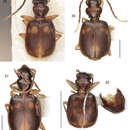Description
provided by Zookeys
(Figs 29, 57). Habitus: (Fig. 29). Size: [See also Table 1] Medium-size for the genus; ABL = 2.768–2.997 mm, SBL = 2.512–2.794 mm, TW (total width) 1.411–1.440 mm, LP = 0.536–0.603 mm, WP = 0.733–0.820 mm, LE = 1.622–1.849 mm. Color: See diagnosis above. Luster: See diagnosis above. Head (Fig. 29): as in description for genus above. Prothorax. Pronotum (Fig. 29) moderately broad, as wide as head across eyes (WH/WP, mean both sexes: 0.964), longer than head (LP/LH, mean both sexes: 1.641), wider than long (W/L, mean both sexes: 1.364); markedly cordiform and explanate, lateral margin beaded with seta at anterior third; anterior angles feebly produced; base markedly constricted with medial lobe at base; hind angle moderately produced and setose; median line well defined, transverse impression punctate, punctures infuscated; surface smooth throughout. Pterothorax. Normal for genus, see description for genus above. Elytra slightly convex; at apical third twice as long as head across eyes (WH/TW, mean both sexes: 0.524) and pronotum (WP/TW, mean both sexes: 0.544), longer than wide. Elytral interneurs striate and continuous along length of entire elytron. Surface with finely impressed microsculpture, sculpticells isodiametric. Hind wings fully developed. Legs. Overall, normal for genus, see description for genus above. Abdominal sterna. Overall, normal for genus, see description for genus above. Male genitalia (Fig. 57, see Fig. 61 for attribute labels). Median lobe with phallobase short about a fourth the length of shaft, basal opening moderately small, oriented parallel to shaft. Shaft narrow, moderately curved ventrally, dorsally sclerotized except for short ostium; in ventral aspect tapered toward rather narrowly rounded apex, in lateral aspect, a rounded apex. Parameres: left very large and broad, right small and triangular, apex of left paramere lobate much longer than right paramere about half the length of shaft (measured in left lateral aspect). Endophallus without preapical spines. Female genitalia. Not investigated, presumably similar to that of Asklepia demiti sp. n.
- license
- cc-by-3.0
- copyright
- Terry L. Erwin, Laura S. Zamorano
- bibliographic citation
- Erwin T, Zamorano L (2014) A synopsis of the tribe Lachnophorini, with a new genus of Neotropical distribution and a revision of the Neotropical genus Asklepia Liebke, 1938 (Insecta, Coleoptera, Carabidae) ZooKeys 430: 1–108
- author
- Terry L. Erwin
- author
- Laura S. Zamorano
Distribution
provided by Zookeys
(Fig. 76). The wide geographical range from near the mouth of the Río Amazon at Belém to the black-waters of Pacaya-Samiria Reserve in Perú on the upper Amazon drainage system is unusual for this genus. But as pointed out in the introduction, very small carabid beetles are not collected by any but carabid specialists, and there have been few of those, working the Amazon Basin.
- license
- cc-by-3.0
- copyright
- Terry L. Erwin, Laura S. Zamorano
- bibliographic citation
- Erwin T, Zamorano L (2014) A synopsis of the tribe Lachnophorini, with a new genus of Neotropical distribution and a revision of the Neotropical genus Asklepia Liebke, 1938 (Insecta, Coleoptera, Carabidae) ZooKeys 430: 1–108
- author
- Terry L. Erwin
- author
- Laura S. Zamorano

